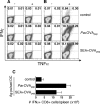Th1 and Th2 cells help CD8 T-cell responses
- PMID: 17325050
- PMCID: PMC1865742
- DOI: 10.1128/IAI.01328-06
Th1 and Th2 cells help CD8 T-cell responses
Abstract
Help from CD4 T cells is often important for the establishment of primary and memory CD8 T-cell responses. However, it has yet to be determined whether T helper polarization affects the delivery of help and/or whether responding CD8 T cells helped by Th1 or Th2 cells express distinct effector properties. To address these issues, we compared CD8 T-cell responses in the context of Th1 or Th2 help by injecting dendritic cells copulsed with the major histocompatibility complex class I-restricted OVA peptide plus, respectively, bacterial or helminth antigens. We found that Th2 cells, like Th1 cells, can help primary and long-lived memory CD8 T-cell responses. Experiments in interleukin-12 (IL-12)-/- and IL-4-/- mice, in which polarized Th1 or Th2 responses, respectively, fail to develop, indicate that the underlying basis of CD4 help is independent of attributes acquired as a response to polarization.
Figures




References
-
- Barber, D. L., E. J. Wherry, and R. Ahmed. 2003. Cutting edge: rapid in vivo killing by memory CD8 T cells. J. Immunol. 171:27-31. - PubMed
-
- Bennett, S. R., F. R. Carbone, F. Karamalis, R. A. Flavell, J. F. Miller, and W. R. Heath. 1998. Help for cytotoxic-T-cell responses is mediated by CD40 signalling. Nature 393:478-480. - PubMed
-
- Bevan, M. J. 2004. Helping the CD8+ T-cell response. Nat. Rev. Immunol. 4:595-602. - PubMed
-
- Buller, R. M., K. L. Holmes, A. Hugin, T. N. Frederickson, and H. C. Morse III. 1987. Induction of cytotoxic T-cell responses in vivo in the absence of CD4 helper cells. Nature 328:77-79. - PubMed
-
- Bullock, T. N., and H. Yagita. 2005. Induction of CD70 on dendritic cells through CD40 or TLR stimulation contributes to the development of CD8+ T-cell responses in the absence of CD4+ T cells. J. Immunol. 174:710-717. - PubMed
Publication types
MeSH terms
Substances
Grants and funding
LinkOut - more resources
Full Text Sources
Other Literature Sources
Molecular Biology Databases
Research Materials

